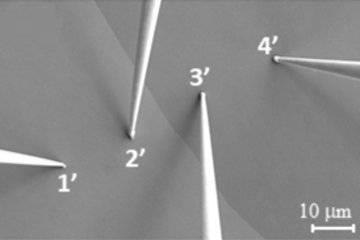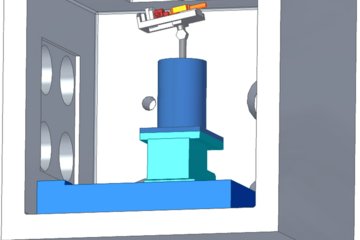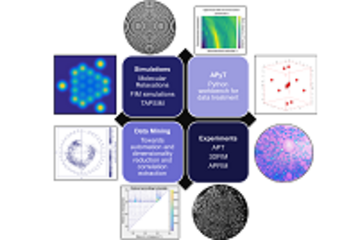All genres
21.
Talk
High Temperature Corrosion in Low Activity Gases - Theoretical Calculations and Experimental Comparison of Oxide, Nitride and Carbide Formation. Gordon Research Seminar on High Temperature Corrosion, New London, CT, USA (2013)
22.
Talk
Phase Diagrams with FACTSage - Speaking different Languages for Thermochemical Properties. GTT-Workshop on Thermodynamic Simulations in Industry, Herzogenrath, Aachen, Germany (2013)
23.
Talk
Facing New Challenges for High Temperature Processes. 224th Meeting of the Electrochemical Society, San Francisco, CA, USA (2013)
24.
Talk
Facing New Challenges for High Temperature Processes. 224th ECS Meeting , San Francisco, CA, USA (2013)
25.
Talk
Internal oxidation and nitridation of hot rolled steels - A theoretical study and its experimental verification. Gunnar Eriksson Symposium & GTT-Workshop on Thermodynamic Simulations in Industry, Herzogenrath, Germany (2012)
26.
Talk
What do we know about internal oxidation in hot-rolled steels? - A theoretical study and its experimental verification. Seminar Talk at Interdisciplinary Center for Advanced materials Simulation (ICAMS), Ruhr-Universtät Bochum, Bochum, Germany (2012)
27.
Talk
Experimental studies and theoretical calculations on the formation of nitrides and oxides during selective oxidation in binary iron-alloys. 8th International Symposium on High-Temperature Corrosion and Protection of Materials, Les Embiez, France (2012)
28.
Talk
Applied Simulations of Thermodynamic Reactions and Interphase Diffusion (ASTRID): Vorstellung des Konzepts und Beispiele zur Korngrenzenoxidation. CDL-Workshop Strukturmodellierung in technischen Metallen, Rust, Austria (2012)
29.
Talk
Theory and Experiment for High Temperature Metal-Gas Reactions. Seminar Talk at Department of Materials Science and Engineering, Carnegie Mellon University, Pittsburgh, PA, USA (2011)
30.
Talk
Connecting Thermochemical Reactions and Diffusion - The Formation of Grain Boundary Oxides in Steel Sheets. 18th Conference on Computer Methods in Materials Technology, Zakopane, Poland (2011)
31.
Talk
Understanding of Hydrogen in Steel by Scanning Kelvin Probe measurements on evaporated Pd-Films. 7th International Conference on Diffusion in Solids and Liquids (DSL 2011), Algarve, Portugal (2011)
32.
Talk
Coupling Thermodynamics and Diffusion for describing Metal/Gas Reactions at elevated Temperatures. Lecture at Institute for Materials Research, Tohoku University, Sendai, Japan (2010)
33.
Talk
Grain Boundary Oxidation Processes and High Temperature Corrosion. Division of Materials and Manufacturing Science, Osaka University, Osaka, Japan (2010)
34.
Talk
Thermodynamische Modellierung von Gasnitrierprozessen. Sitzung des AWT Fachausschusses Nitrieren / Nitrocarburieren FA3, Gummersbach, Germany (2010)
35.
Talk
Thermodynamic Studies of Hydrogen Permeation and the Effect of Oxide Formation in Pure Iron Samples. 6th International Conference on Diffusion in Solids and Liquids, Paris, France (2010)
36.
Talk
Grain Boundary Oxidation Processes and High Temperature Corrosion. GTT-Workshop on Thermodynamic Simulations in Industry, Herzogenrath, Aachen, Germany (2010)
37.
Talk
Thermodynamic Simulations of the Oxidation Processes in Polycrystalline Metallic Alloys. International Workshop “Grain boundary diffusion, stresses and segregation”, Moscow, Russia (2010)
38.
Talk
Thermodynamic Stability and Reaction Sequence for High Temperature Oxidation Processes in Steels. International Symposium “High Temperature Oxidation and Corrosion”, Zushi (Tokyo), Japan (2010)
39.
Talk
Selective Oxidation of Hot Rolled Steels - A combined Theoretical and Experimental Study.
40.
Poster
High Temperature Corrosion in low-activity gases - Theoretical Calculations and Experimental Comparison of Oxide, Nitride and Carbide Formation. Gordon Research Seminar on High Temperature Corrosion, New London, CT, USA (2013)











